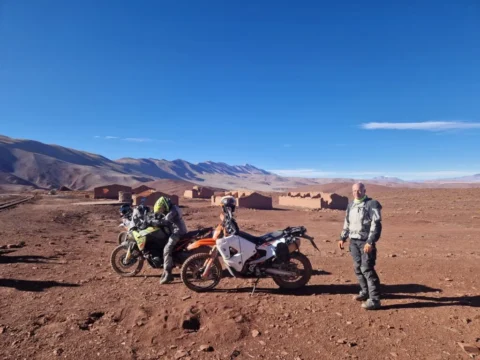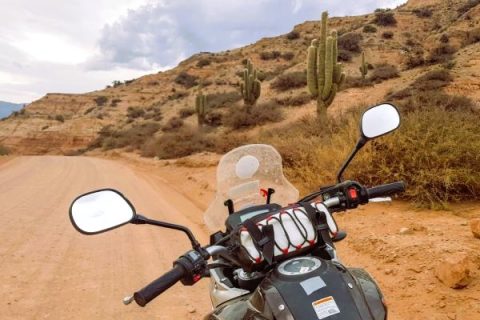Motorcycle Journey Through India. Travel Diary.
A motorcycle journey through India and Nepal is a thrilling adventure filled with challenges, difficult roads, and awe-inspiring landscapes. An early morning departure from Nepal promised a smooth ride, but missing bridges and chaotic Indian traffic quickly reminded us that nothing is predictable on this trip. India is not only about road challenges but also spiritual experiences, such as the ritual baths of pilgrims in the Ganges in Haridwar or discovering the colonial history of Shimla. Every kilometer brings us closer to the magnificent Himalayas, with their narrow, winding roads and majestic views. Along the way, we encounter Buddhist monasteries, steep mountain passes, and friendly locals. This adventure is packed with intense moments and unforgettable experiences, making it a one-of-a-kind journey through the heart of Asia.
Crossing from Nepal to India
We set off from Hattisar at 6 AM, unsure of what surprises awaited us along the way. The mud, which could have posed a problem, had mostly dried up, making the journey relatively easy. The biggest surprise, however, awaited us at the river—it had transformed into a small stream that we crossed effortlessly. Once on the main road, we discovered that two bridges were missing. Luckily, the rivers were dry that day, allowing us to cross without much difficulty.
After 40 kilometers, we reached the massive Karnali River. In Chisapani, we were greeted by a pleasant surprise—a modern bridge, one of the most advanced in Nepal. Fortunately, we didn’t need to worry about its stability. We still had about 100 kilometers to the Indian border. We crossed at the quiet Mahendranagar-Banbasa checkpoint. The Nepalese customs process took just 15 minutes, although Jurek completely missed the customs office, so we had to turn back. The Indian side took a bit longer—about half an hour—but it was smooth.
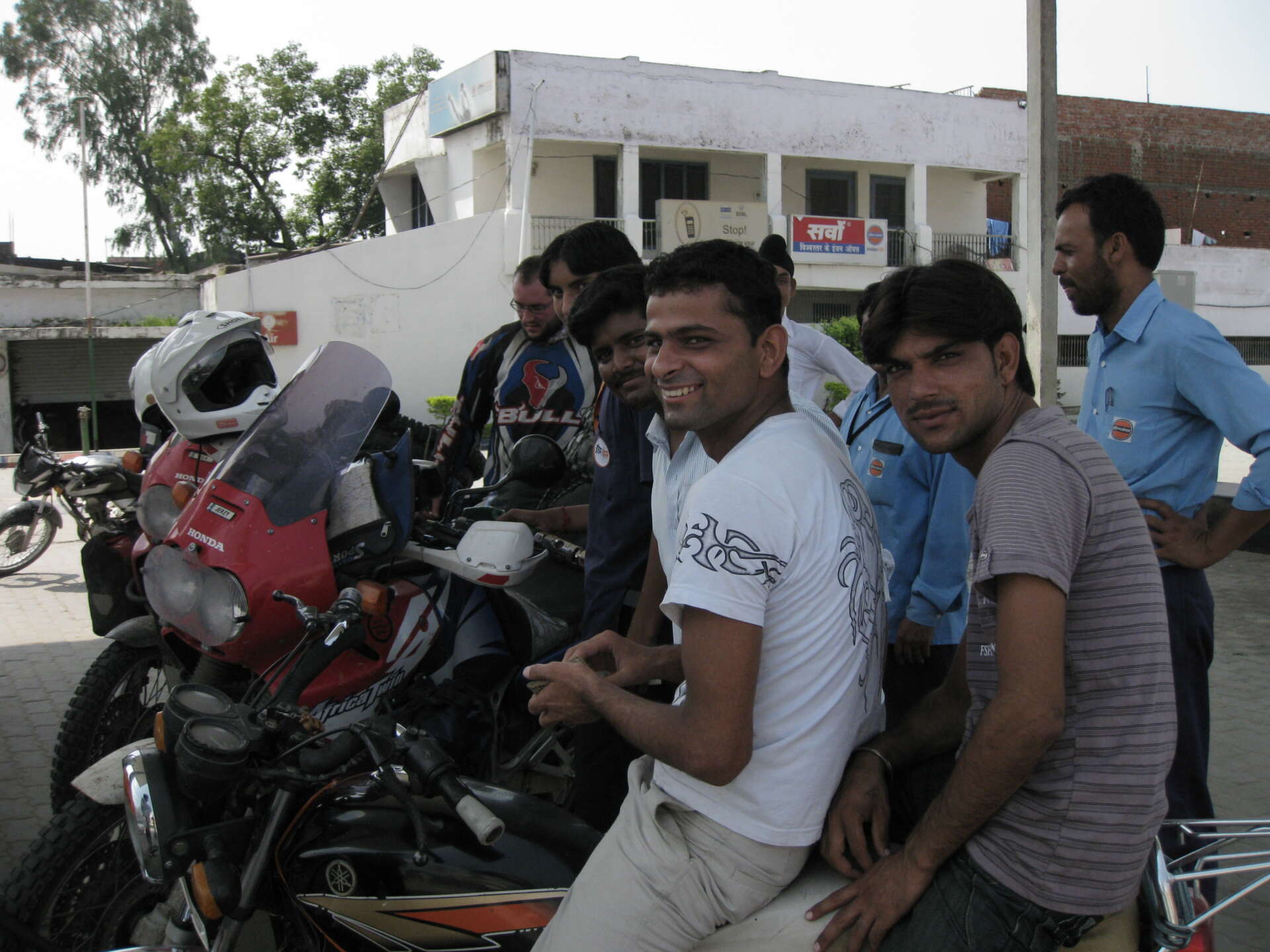
Differences in driving style on the roads
Driving on Indian roads isn’t much different from Nepal, except that trucks and cars here are even more reckless and never yield. Motorbikes fare a bit better, as they don’t cut in front as aggressively as in Nepal. However, the traffic is heavy, so we have to be extra cautious, especially with all the animals roaming around. Riding here is tough, but perhaps Iran was a bigger shock. Maybe it’s the number of kilometers we’ve covered…
The average speed on Indian asphalt roads is 20-30 km/h, so we must plan our daily routes carefully. We aim to reach Shimla as quickly as possible and then head into the Indian Himalayas, choosing a route through Haridwar and Shimla. Our first night is spent in Kashipur, about 150 km from the border. The town itself isn’t particularly exciting, but after a full day of riding, we’re too tired to continue. At least we can enjoy some delicious Indian food, a pleasant way to end the day.
Motorcycle Journey Through India: Haridwar
The next stop on our route is the holy Hindu city of Haridwar. It is here that the Ganges finishes its mountainous journey and flows calmly onto the plains. Thousands of Hindus make pilgrimages to this place to bathe in the Ganges, which is still clean here, and offer prayers for the memory and well-being of their families. The Ganges still has a strong current here, and chains are fixed on both sides of the river for pilgrims to hold onto during their ritual baths.
Haridwar – A Holy City on the Ganges
Haridwar is one of the most important pilgrimage cities in India, located on the right bank of the Ganges at the foothills of the Himalayas. For Hindus, it is a sacred place considered the gateway to the kingdom of the gods.
Every evening after dusk, communal prayers take place on the banks of the Ganges. Massive crowds gather, and people release offering “flower boats” with lit candles into the river. The entire river is dotted with these “glowing boats,” creating a magical scene.
The road from Kashipur to Haridwar is about 170 km, which doesn’t seem far. However, one must account for the jungle-like Indian traffic and the complex routes through larger cities, where chaos is even greater. Roaming animals are also a common sight. Despite this, the ride is smoother than the previous day, and it feels like we’re beginning to adapt to the realities of India.
The most challenging part is the heat – it’s hot and humid, almost unbearable. It only becomes pleasant in the evening during the riverside prayers. In Haridwar, we are most amazed by Har-ki-Pairi, a place where Hindus perform their ritual baths in the Ganges. We spend several hours there, observing Hindu customs and the evening prayers. The number of people, the vibrant colors, the sounds, and the chanting are overwhelming. Thanks to our visit to Haridwar, we experienced an authentic Hindu atmosphere we had never felt before.
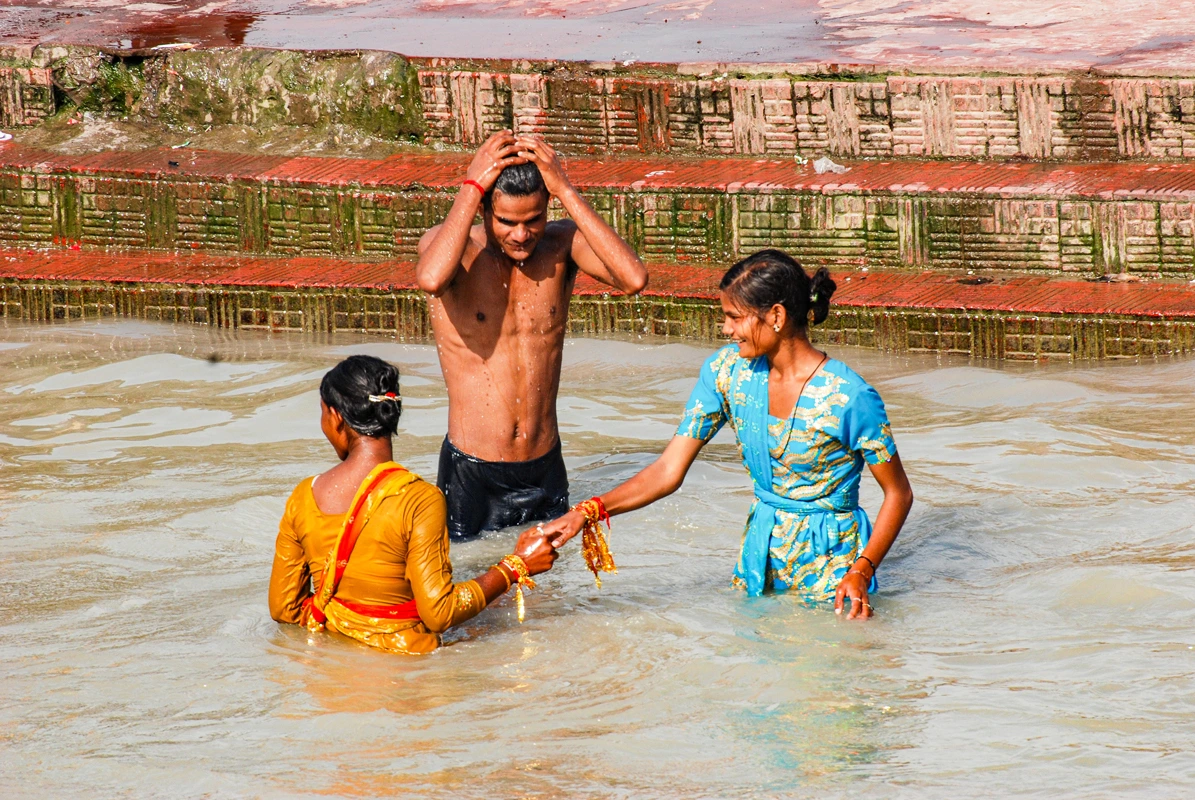
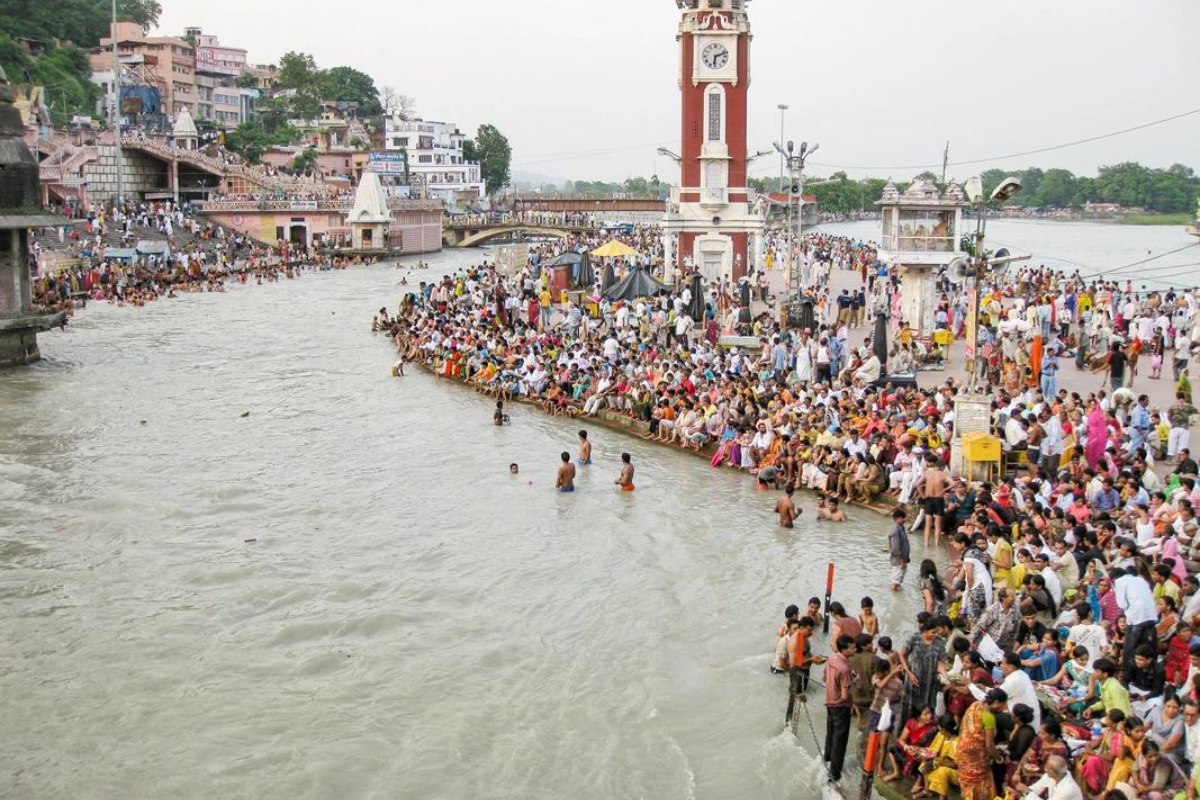
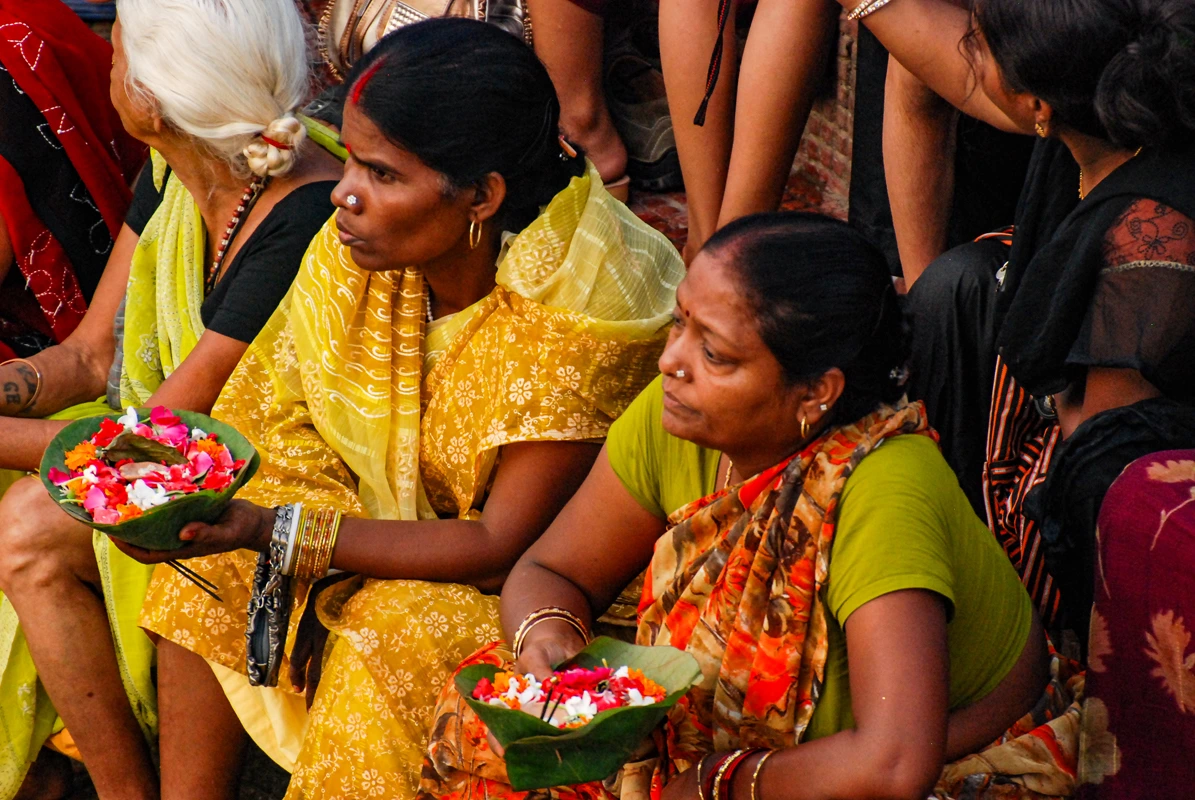
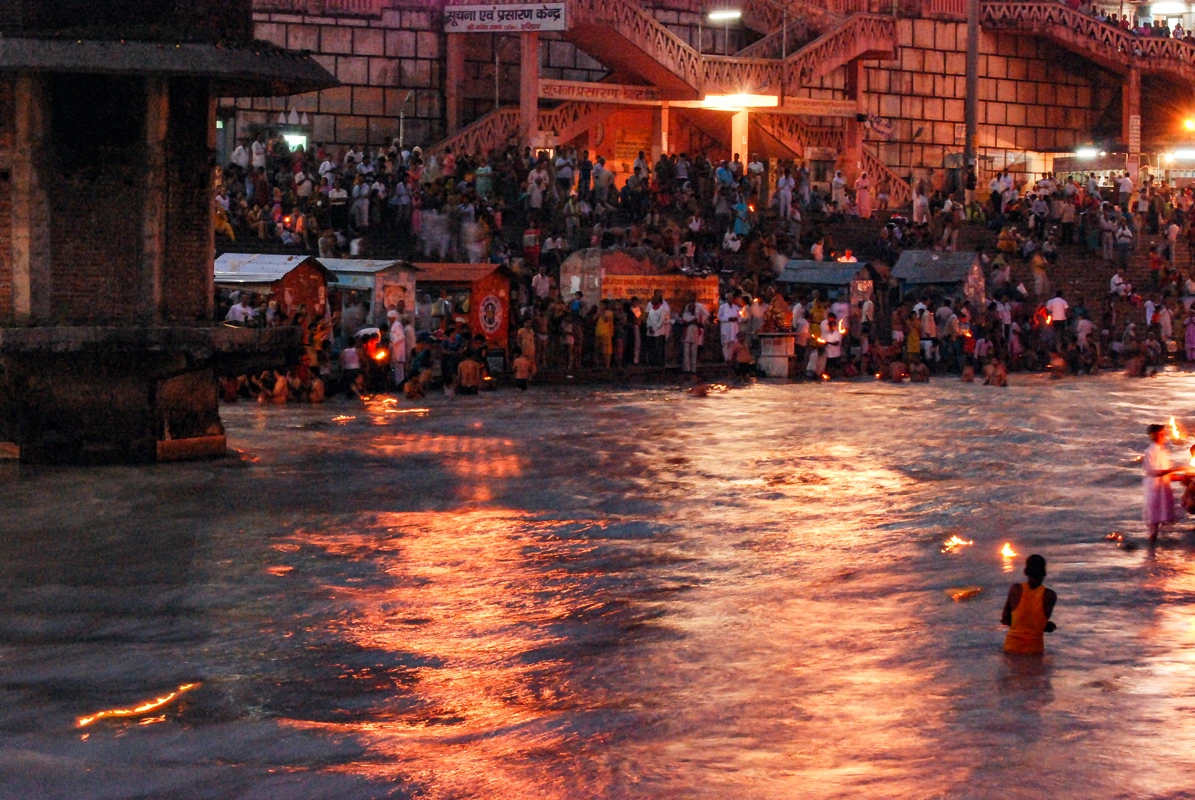
Har-ki-Pairi – A Sacred Place
Har-ki-Pairi is one of the most sacred places in Haridwar, India. It is a ghat along the banks of the Ganges River, where devotees from across the country come to bathe in its holy waters, believing it brings spiritual purification. Every evening, a spectacular aarti ceremony takes place, where thousands of people pray and release lit lamps on small flower boats into the river. This place is full of spiritual energy and is a significant destination for pilgrims.
Motorcycle Journey Through India – From Haridwar to Shimla
We depart from Haridwar, heading straight for Shimla, leaving behind the Uttaranchal region and entering Himachal Pradesh. We’ll surely return to Uttaranchal one day to explore the lush Garhwal Himalayas and visit the sacred Hindu sites, such as Char Dham.
Shimla holds great historical significance. For nearly a century, from the mid-19th to the mid-20th century, it served as the summer capital of India. During the scorching months, the entire Indian government moved here, and major decisions were made. It was also in Shimla where the partition of India and Pakistan was signed. The city is steeped in colonial architecture, with a noticeable British style everywhere. The most iconic building is the Scottish-style castle, which once served as the summer residence of the Viceroy of India. Today, it houses a scientific institute.
Shimla is situated on a steep hillside, so the city has public elevators to help people move from the lower to the upper parts. The views of the surrounding mountains are breathtaking. However, the road to Shimla was exhausting. After leaving Haridwar, we had to pass through the crowded capital of the region – Dehra Dun, where road signs were almost nonexistent. Then, quite suddenly, we found ourselves in the mountains, which was a pleasant surprise. Traffic decreased significantly, and the heat became less oppressive. The road became narrow and winding, requiring us to exercise great caution, especially when passing cars, buses, and trucks coming from the opposite direction. Many times, we passed with just millimeters to spare.
The Indian side of the Himalayas is entirely different from what we saw in Tibet. Here, the mountains are covered in lush, steep forests, while in Tibet, there wasn’t a single tree, creating a completely different landscape.
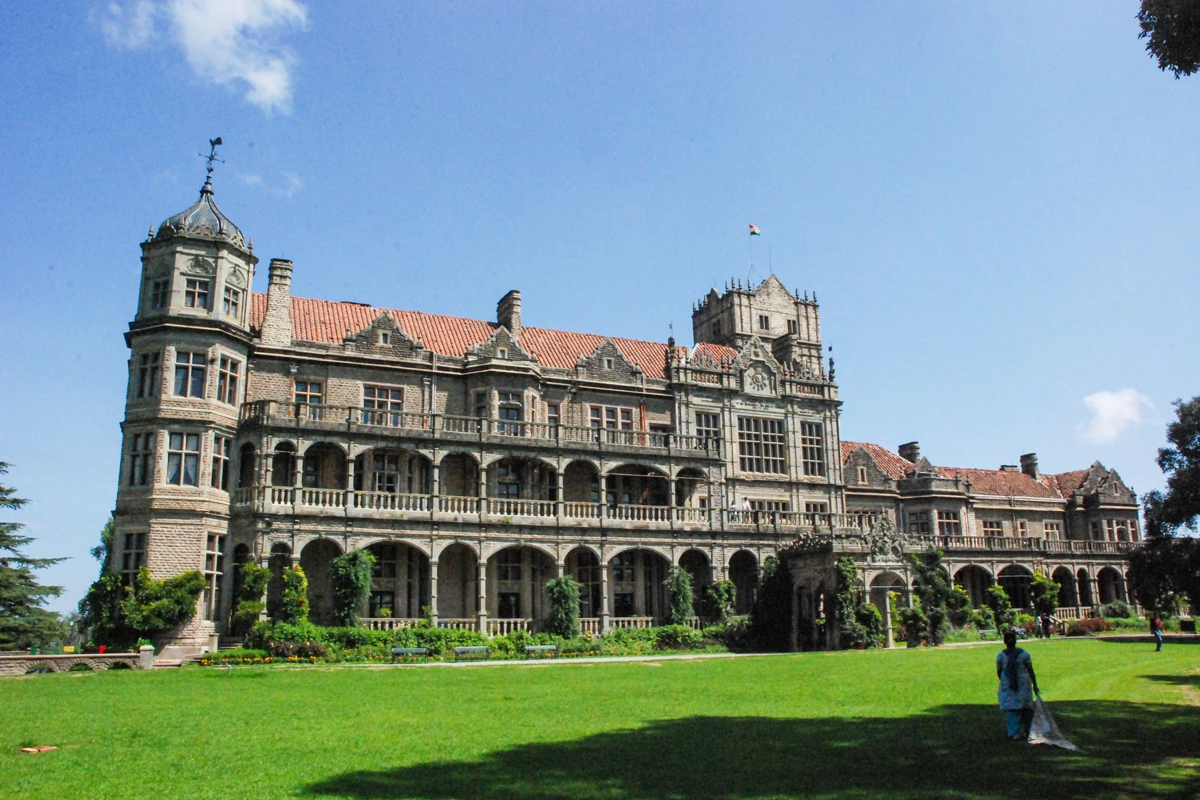
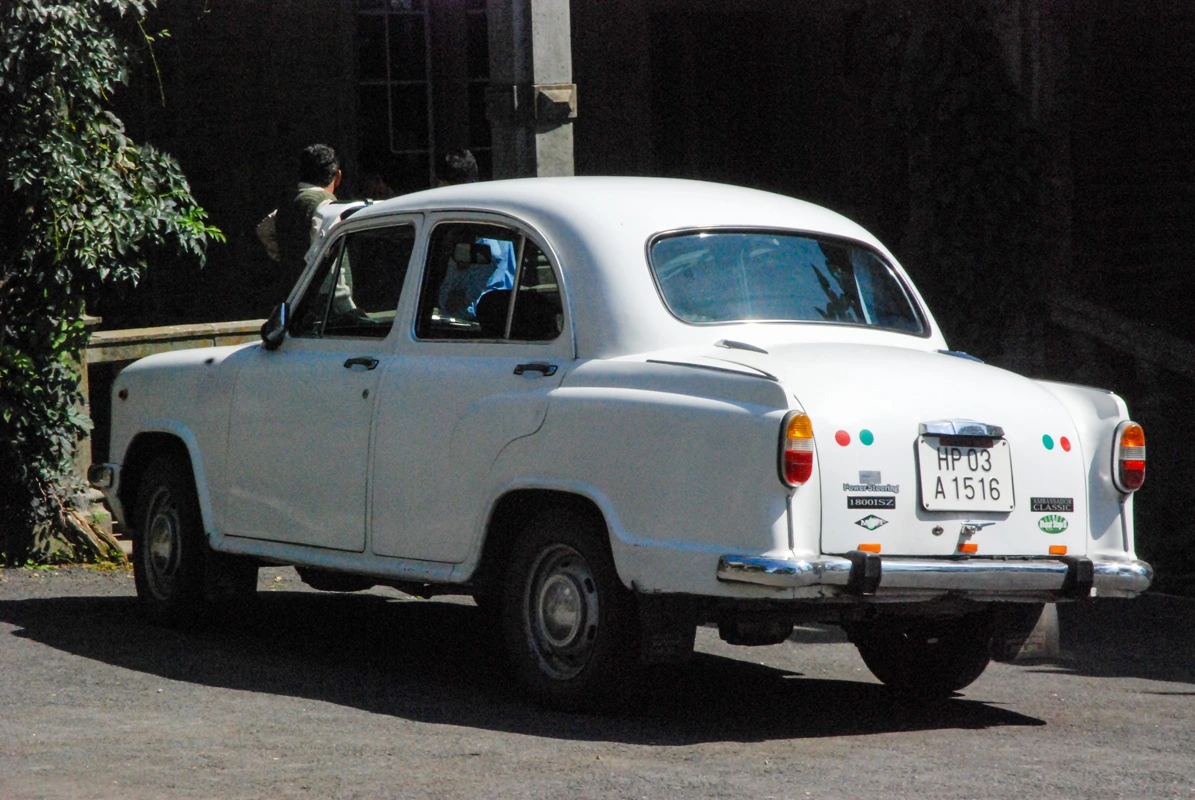
Mountain Landscapes – From Shimla to Sarahan
Leaving Shimla, the real mountain road begins. The number of hairpin turns with steep drops right next to the edge, as well as climbs and descents, is surprisingly high. The ride is thrilling, with one turn leading to another. The asphalt is decent, and the traffic is manageable. After crossing several smaller mountain ranges, we descend into the Satluj River valley, where the heat once again becomes intense. This section of the road follows the river, with the last 20 kilometers being a steep climb to several hundred meters in elevation.
Our destination is the small town of Sarahan, once the summer residence of the Maharajas of Bushahr. Here, we find the mysterious Bhimkali Temple, which is over 800 years old. The temple is built in a typical style for the Kinnaur Valley, with alternating layers of wood and stone to protect it from earthquakes. From the windows of our guesthouse, we have a breathtaking view of the entire valley.
Bhimkali Hindu Temple
The Bhimkali Temple is an ancient Hindu temple, over 800 years old, located in Sarahan, in the state of Himachal Pradesh, India. Built in a unique architectural style combining stone and wood, the temple is dedicated to the goddess Bhimakali, a form of Goddess Kali. It is a significant pilgrimage site, renowned for its mystical atmosphere and breathtaking views of the Himalayas.
Motorcycle Journey Through India: Route from Sarahan to Kalpa
The route from Sarahan to Kalpa is an exceptionally thrilling stretch. Half of the road is a narrow path carved into the rock, hundreds of meters above the surface of the Satluj River. On one side, there’s solid rock, while on the other, a steep drop-off. Riding through such terrain greatly raises the adrenaline, especially when passing other vehicles.
The second part of the route feels more like a construction site. For several kilometers, we pass the development of multiple dams along the Satluj River. The road here is wider and lower but unpaved, so we have to navigate through light mud left by the passing trucks.
The landscape of the valley changes dramatically—from untouched, green mountains to an industrial scene. Jurek is fascinated, watching the machinery and technical solutions with keen interest. However, I find myself longing for the natural greenery. In Rekong Peo, one of the larger towns in the Kinnaur Valley, we arrange our Inner Line Permit, which is essential for passing through the restricted border zone with Tibet.
From Rekong Peo, we take a steep, narrow, and winding road to the small village of Kalpa. Kalpa enchants us with its beautiful views of the nearby Kinnaur Kailash. In the village, a Buddhist monastery and a Hindu temple stand side by side in harmony. We find a great place to stay, where the window offers a stunning view of the entire valley and Kinnaur Kailash.
The Inner Line Permit (ILP) is a special authorization required for foreigners and some Indian citizens to visit designated border areas in India. The ILP is mandatory in regions such as Arunachal Pradesh, Nagaland, Mizoram, and parts of Sikkim and Ladakh. Its purpose is to protect sensitive border zones and preserve the cultural and ecological integrity of these areas. To obtain an ILP, travelers must apply at designated administrative offices or online, providing their travel plans and necessary documents.
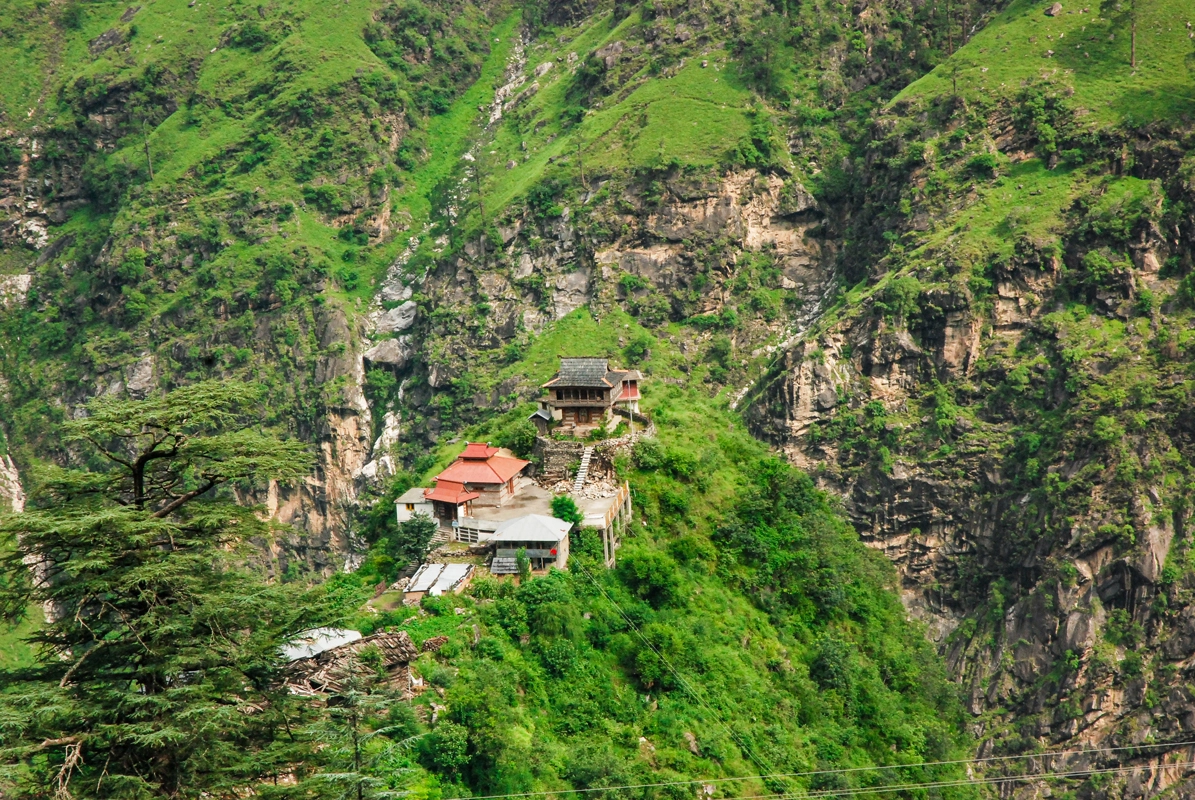
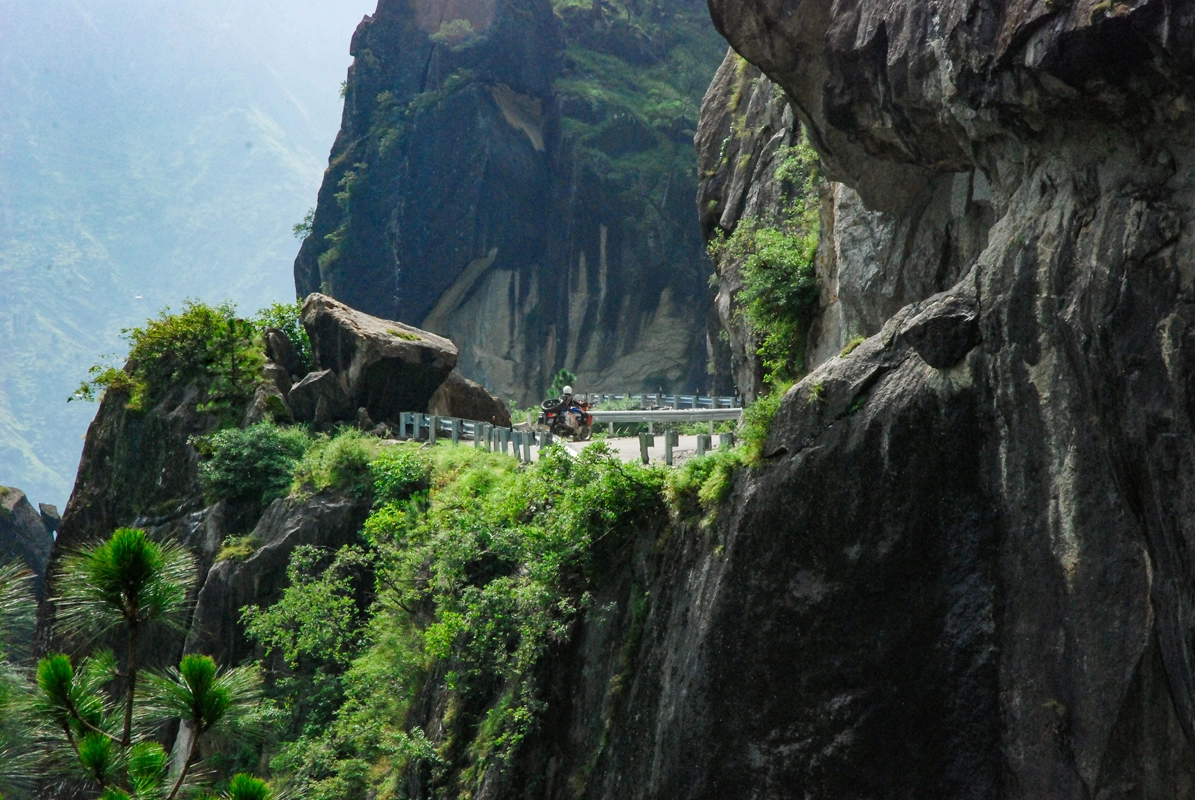
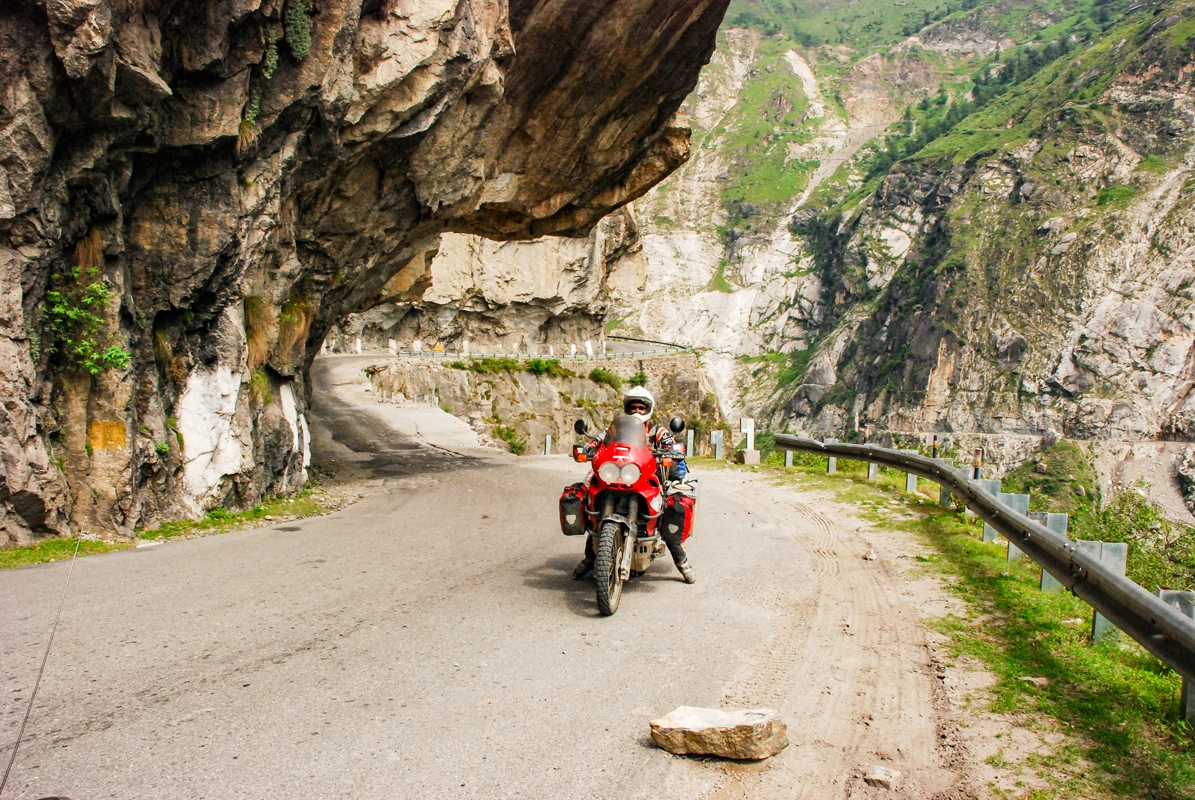
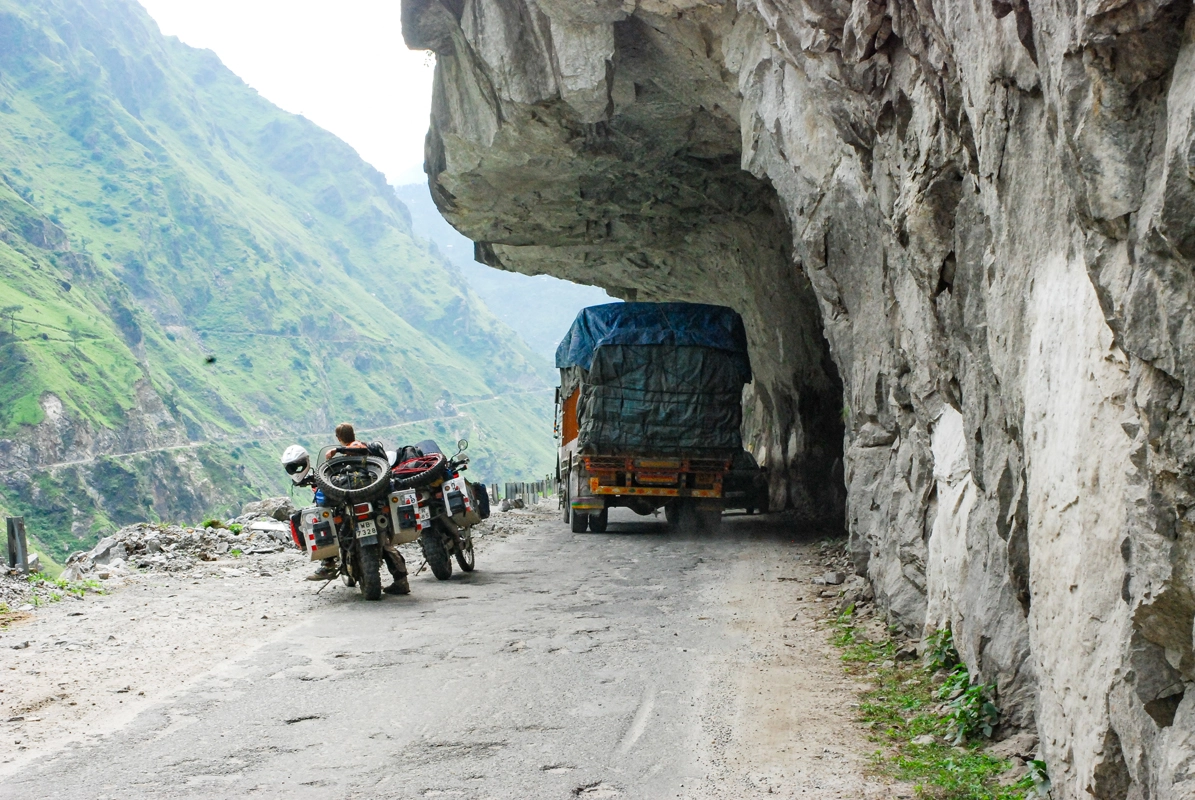
Road from Kalpa to Tabo – Motorcycle Journey Through India
Droga z Kalpa od początku zapowiada się emocjonująco. Wąska ścieżka wyżłobiona w skale, zawieszona nad kilkusetmetrowym urwiskiem nad rzeką, robi ogromne wrażenie. Brak barierek dodaje adrenaliny, a mijanie ciężarówek wymaga sporej zręczności. W połowie dnia wjeżdżamy do Doliny Spiti, gdzie spotykamy innych motocyklistów, głównie Hindusów na Royal Enfieldach. Nasze maszyny wyglądają przy nich jak potężne bestie.
W kilku miejscach droga jest poprzerywana osuwiskami skalnymi, które musimy omijać po karkołomnych objazdach. Na jednym z nich utknęła ciężarówka, która nie mogła podjechać pod stromy odcinek. Wycofanie naszych dużych motocykli Honda Afryka Twin na stromiźnie nie jest łatwe, ale musimy zrobić miejsce. Ciężarówka cofa się dosłownie na milimetry nad urwiskiem, dopiero wtedy możemy zmierzyć się z podjazdem. Po kilkudziesięciu kilometrach stromych serpentyn docieramy do Nako, buddyjskiej wioski położonej na wysokości prawie 4000 metrów.
Jesteśmy bardzo blisko granicy z Tybetem, a wioska i jej mieszkańcy przypominają nam to, co widzieliśmy po drugiej stronie Himalajów. W Nako spotykamy Rosjanina, który od roku mieszka w Indiach. Opowiada nam o swoim życiu w tym kraju. Razem z nim ruszamy dalej. Droga jest karkołomna, znowu zmagamy się z wąską, skalistą ścieżką, prowadzącą stromo w dół. Pod wieczór docieramy do Tabo, miasteczka słynącego z jednego z najważniejszych buddyjskich monasterów w Dolinie Spiti. Monaster ma już tysiąc lat, a niektóre malowidła na ścianach liczą po kilkaset lat. Jest to największy klasztor w całym Spiti. Wieczorem spotykamy Alberto, Włocha podróżującego po Himalajach na Transalpie. Wspólna kolacja szybko zbliża nas do siebie, więc decydujemy się kontynuować podróż razem.
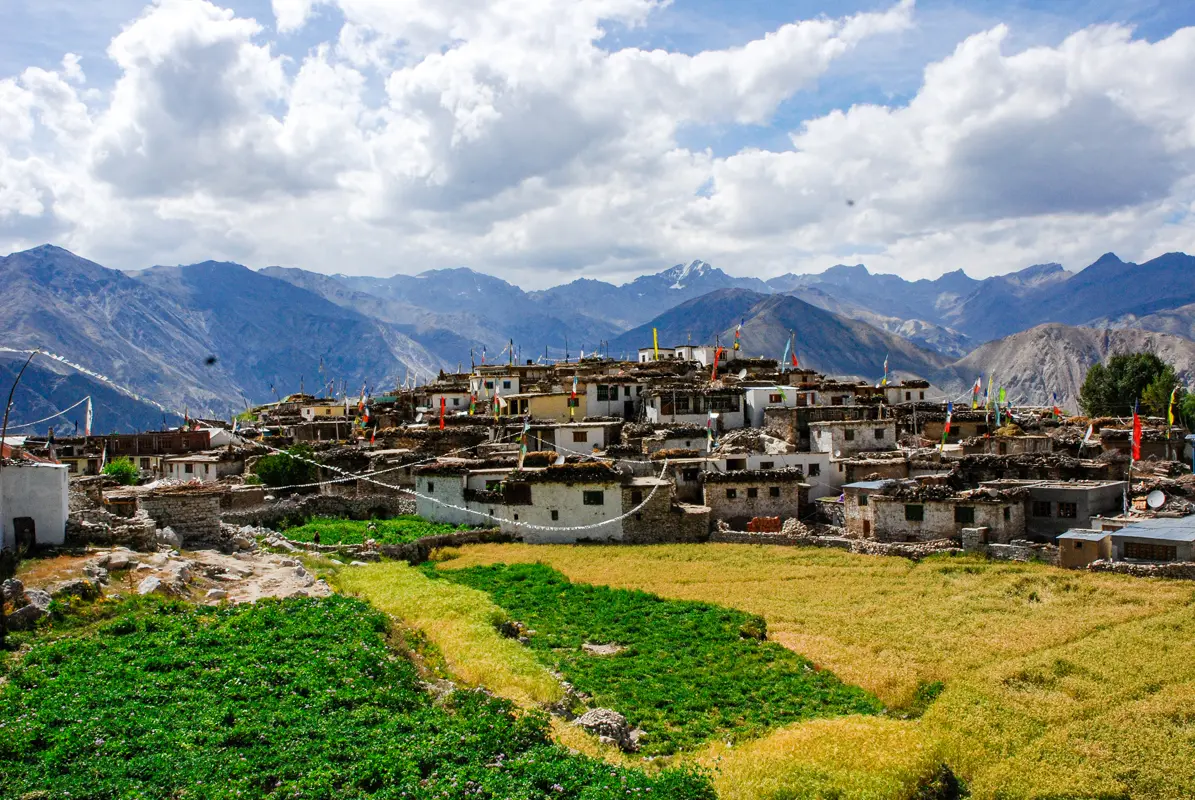
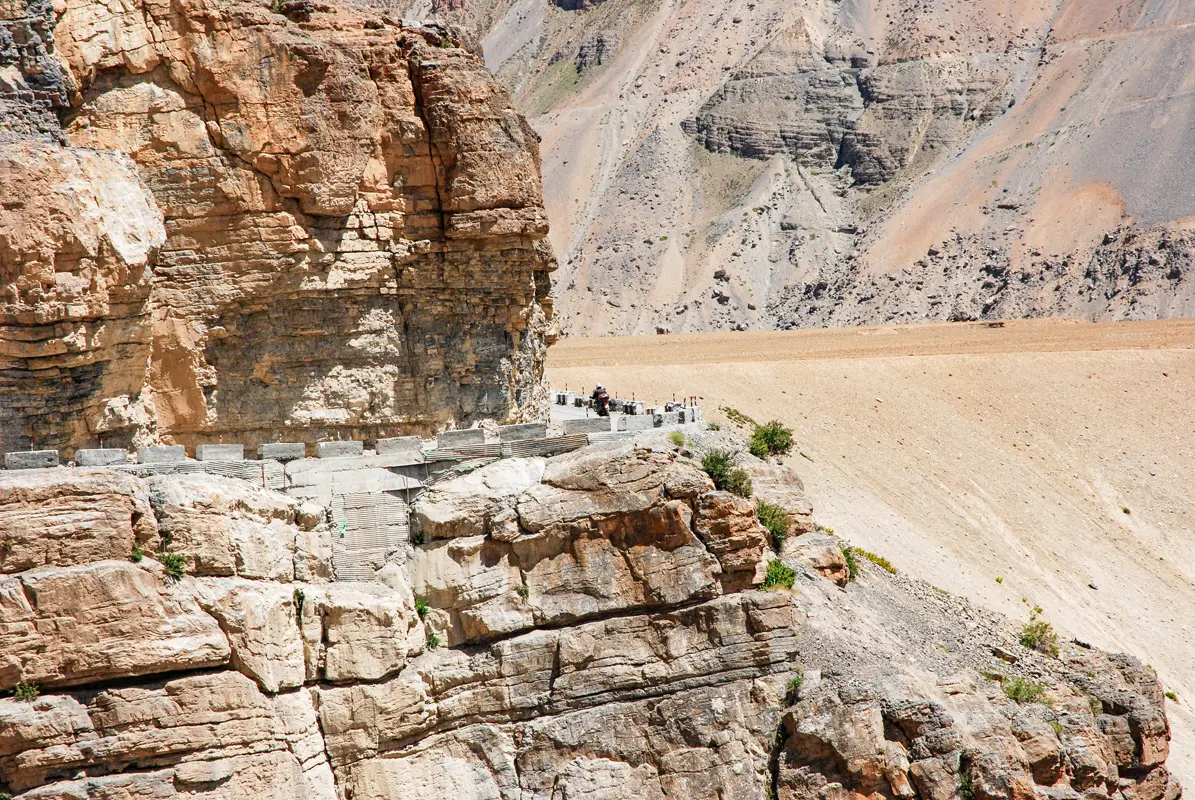
Magnificent Monasteries in the Spiti Valley
The monasteries in the Spiti Valley are among the oldest and most significant Buddhist temples in the Himalayan region. Notable among them is the Tabo Monastery, known as the “Ajanta of the Himalayas,” which is over 1,000 years old and one of the oldest continuously functioning monasteries in the world. Other prominent monasteries include Key Monastery, perched on a steep hillside, and Dhankar Monastery, dramatically situated on a cliff with breathtaking views of the Spiti Valley. These monasteries are not only places of prayer and meditation but also treasure troves of ancient murals, sculptures, and manuscripts, which have drawn pilgrims and travelers for centuries.
Motorcycle Journey Through India – From Tabo to Kaza via Spiti and Pin Valleys
Early in the morning, we explore the Tabo Monastery, one of the oldest and largest Buddhist monasteries in Spiti. The entire complex is impressive, and the over 600-year-old original murals leave a lasting impression. A friendly monk shares a few anecdotes from the monastery’s history. After this delightful start to the day, we pack our motorcycles and, along with Alberto, continue our journey.
After just a few kilometers, we arrive at the Dhankar Monastery, perched high on a cliffside, a few kilometers off the main road. The steep switchbacks demand careful attention, but the view from the top is worth every effort. The entire village on the cliff’s edge is unique, though parts of the monastery buildings have fallen into disrepair. After exploring, we descend into the Pin Valley, known as the valley of the snow leopard, considered one of the most beautiful valleys in the Indian Himalayas.
At the entrance to the valley, we visit another Buddhist monastery and then enjoy the stunning views and the relatively easy dirt road. After around 50 km, we reach the charming village of Mud, where the road ends. From here, further travel is only possible on foot. Mud is a small town consisting of a few buildings and eateries, with its biggest attraction being the panoramic views. We stop for lunch at a quaint café and encounter a group of Israeli tourists.
As we return to the main road, the valley appears even more beautiful than before. In the evening, we reach Kaza, one of the larger towns in the Spiti Valley. While Kaza itself doesn’t have much to offer, we decide to stay the night and enjoy the comforts of civilization that we’ve missed over the past few days.
Visiting Key Monastery
We begin the next day by visiting another significant Buddhist monastery in Spiti – Key. This time, the climb up the steep valley slope is slightly easier, with gentler switchbacks. At the monastery, we arrive just in time for the monks’ prayer session. The rhythmic Buddhist chanting creates a trance-like atmosphere. The monks offer us milk tea and share stories of the monastery’s history. It’s a peaceful, non-touristy visit that we thoroughly enjoy.
Key Monastery is the largest and most important Buddhist monastery in the Spiti Valley, located at an altitude of approximately 4,166 meters (13,668 feet) above sea level. Founded in the 11th century, it is one of the main centers of Buddhist learning in the region. The monastery has a distinctive fortress-like structure, and its location on a steep hillside provides spectacular views of the surrounding landscape. Inside, there are valuable wall paintings, Buddha statues, and ancient manuscripts. It serves not only as a place for spiritual practice but also as a cultural and educational hub for the local monk community.
Between Key Monastery and Losar, where there’s a police checkpoint, the landscape starts to resemble a lunar scene. Vast, barren mountains dominate the view, with a thin blue line of the river snaking through the valley below. The road clings to the mountainside in some sections, while at other times it descends to run parallel to the river at the valley floor. At Losar, the police recorded our passport details before we set off to tackle our first major pass of the day—Kunzam Pass (4,551 meters above sea level).
The smooth tarmac quickly gave way to a slow, bumpy, and winding ascent on rough gravel. It was tough going, especially when overtaking the lumbering trucks along the way. The descent proved even more challenging, with steep and narrow switchbacks littered with stones and potholes. The strain of navigating this difficult stretch of road began to take its toll, and we soon realized that this was just the beginning of the hurdles we would face on this route.
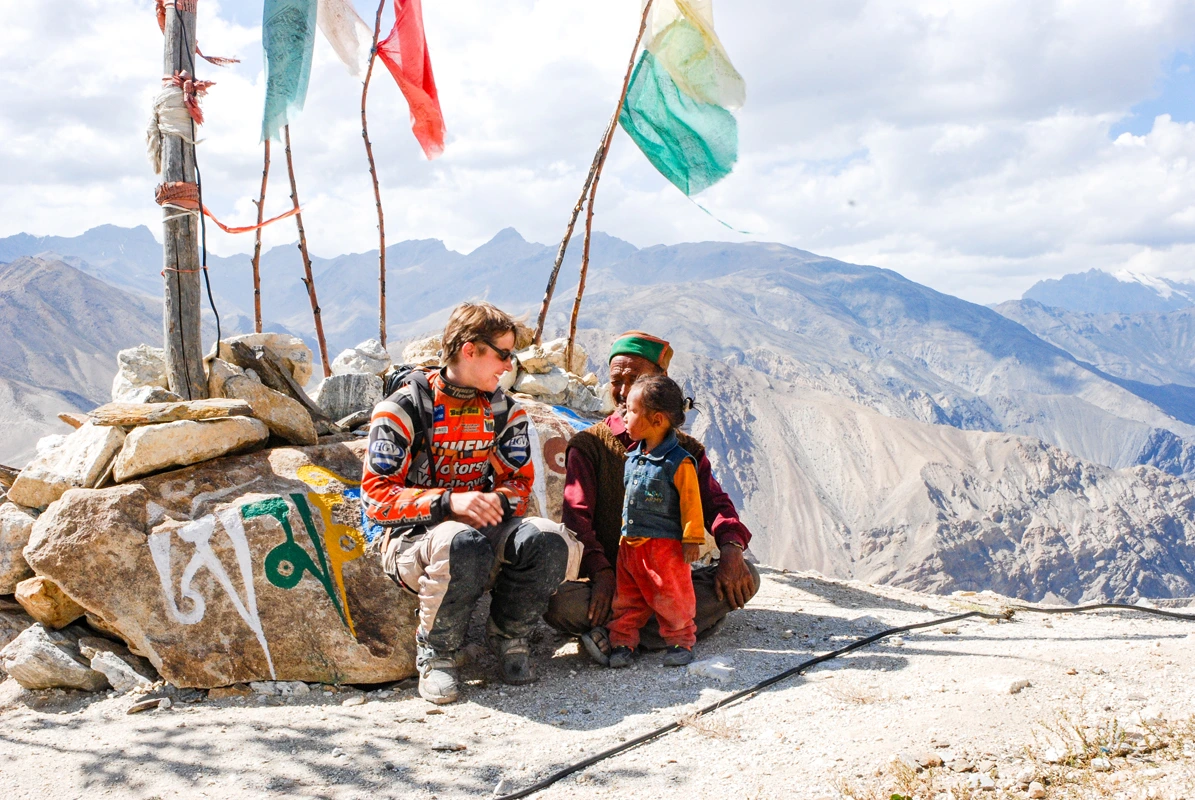
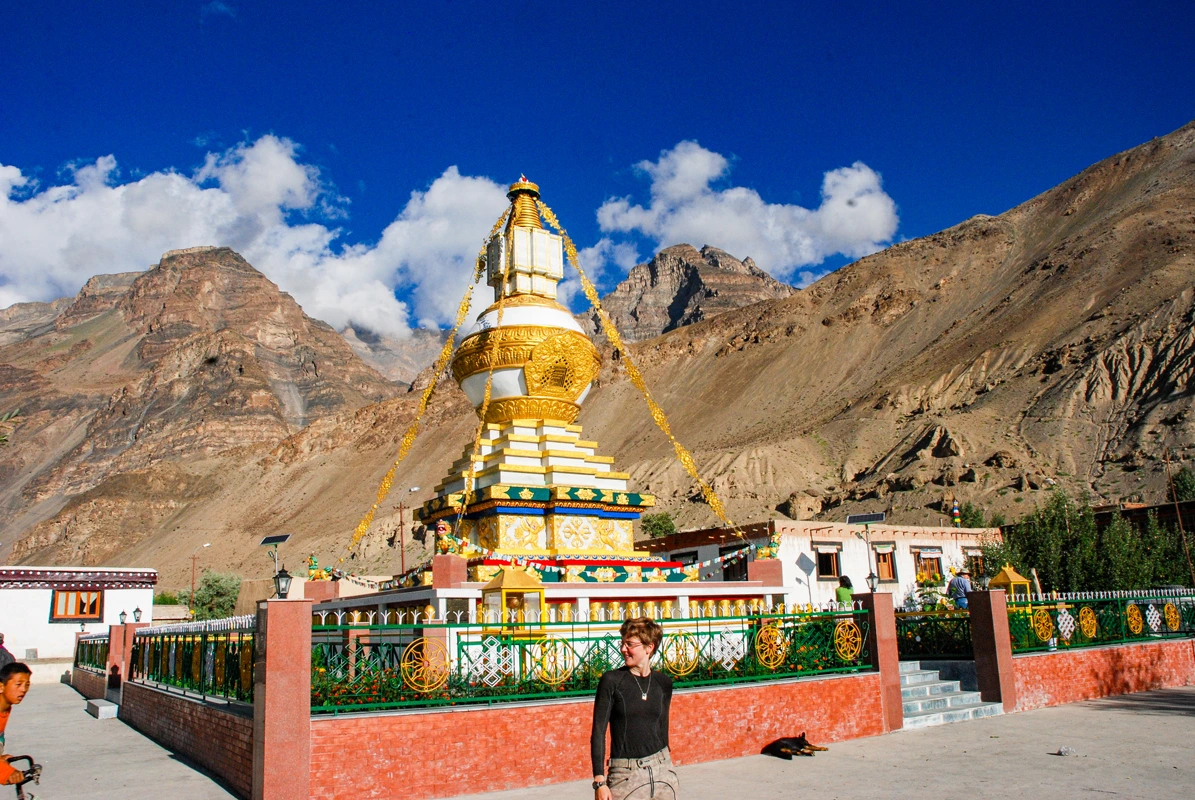
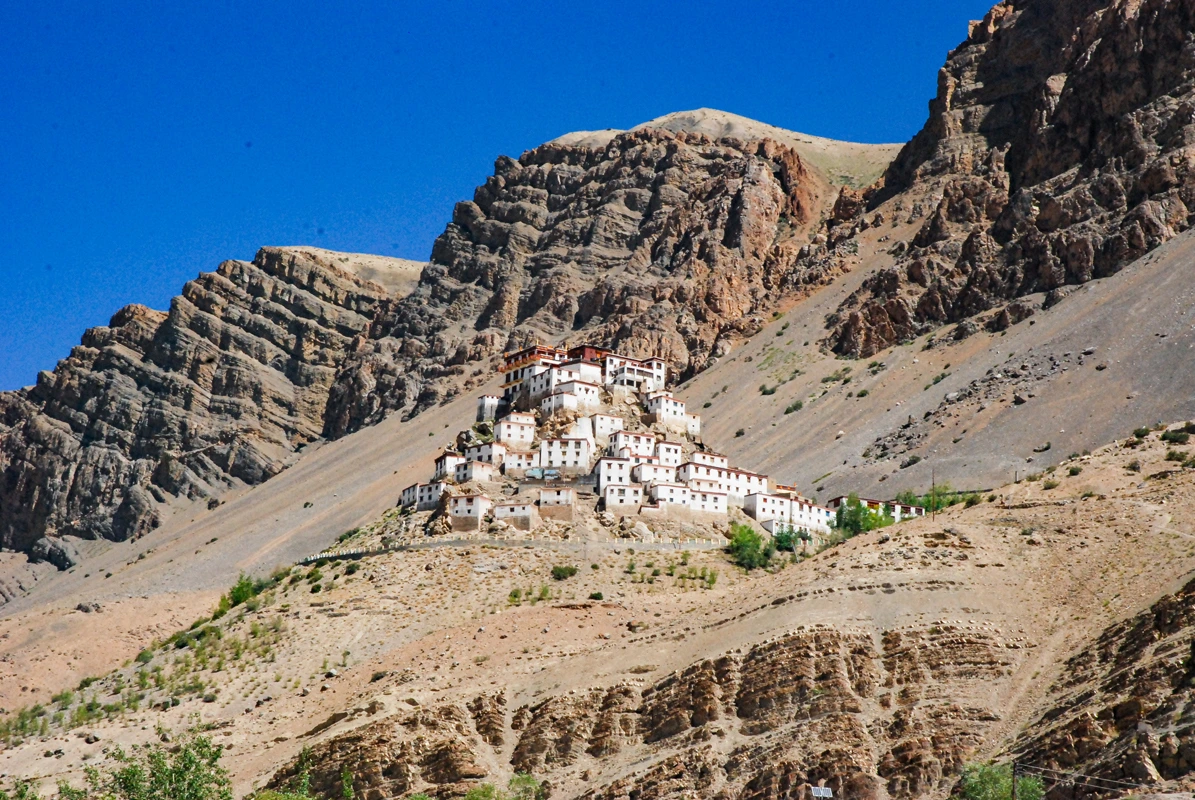
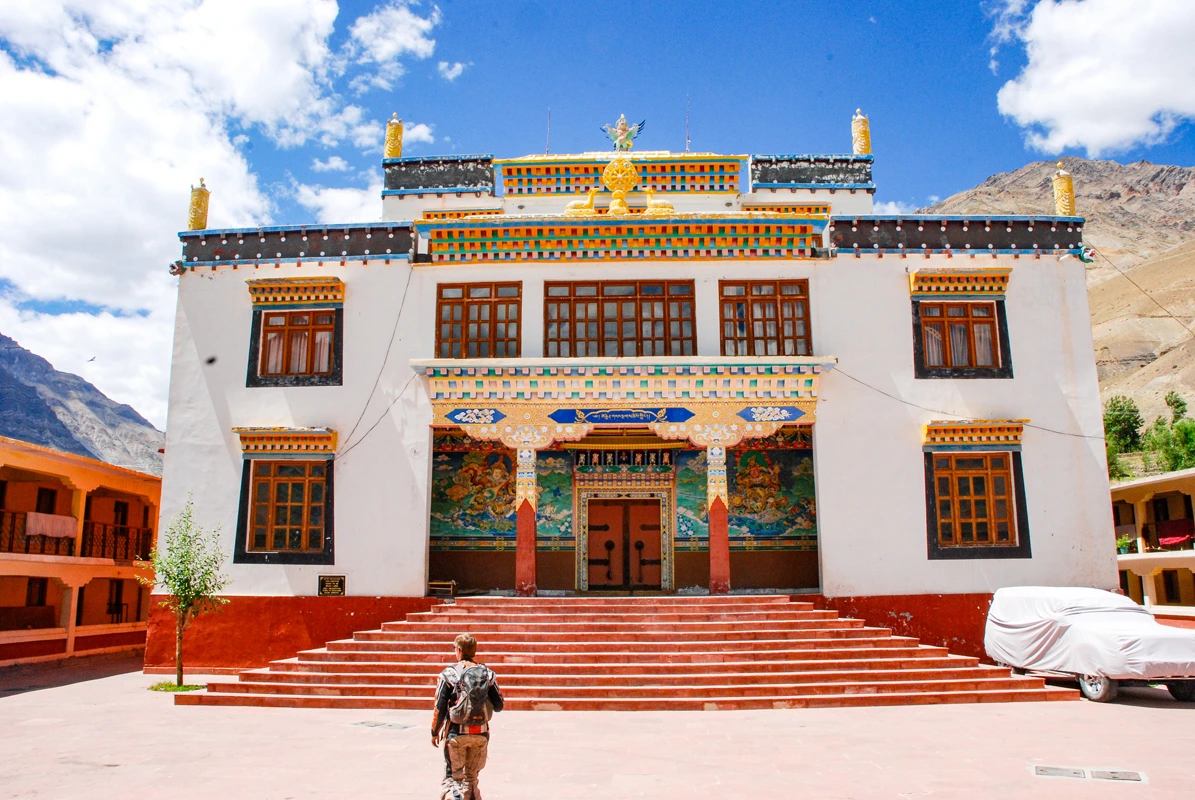
The Road to Chandar Tal Lake
A few kilometers after the Kunzam Pass, we turned onto a smaller, even narrower road leading to Chandar Tal Lake. The ten kilometers we had to cover were incredibly thrilling and probably the most challenging stretch of road we’ve encountered in India. The sandy path clung precariously to the cliffside, with rushing streams cutting across the road, and the final challenge was a series of steep, sandy switchbacks. It felt like a true adventure navigating this rugged terrain to reach the moraine where the lake is located.
By the time we arrived at Chandar Tal, we were exhausted. Unfortunately, we couldn’t ride all the way to the shore—the last 500 meters had to be covered on foot. However, the walk at the end of the day turned out to be a welcome break. We grabbed a quick meal at a local dhaba (a roadside tent offering food) by the lake. While the lake was undoubtedly picturesque, we decided to set up our camp closer to our bikes, near the river. Carrying all our gear up to the lake didn’t seem appealing. Together with Alberto, we set up our two-tent camp by the river at an altitude of 4200 meters.
In the evening, a few Royal Enfield motorcycles, which we had encountered earlier, showed up. While their riders took a bit longer to navigate the terrain, they eventually made it. Camping amidst the majestic Himalayas was an atmospheric experience, although the night was brisk. Fortunately, our trusty Yeti sleeping bags, made by a Polish brand, performed flawlessly, keeping us warm and comfortable.
Motorcycling through India: Journey from Spiti Valley to Pang
Leaving Spiti Valley behind, we spent the entire day riding through the rugged Lahaul Valley. Lahaul is even wilder and more challenging than Spiti. The mountains here are incredibly dry, and the road is frequently just a sandy track carved out by trucks and buses. In many sections, it’s hard to even call it a road, with the terrain being rough and bumpy. The rivers, although not deep, are filled with large stones, making it a real test of skill and endurance. Navigating through them requires a constant battle with the rocky riverbeds, and our feet are soaked by the end of it. Luckily, the warm weather helps.
Lahaul Valley doesn’t have any monasteries to visit; the views are its main attraction. It’s a day full of intense riding rather than sightseeing. It isn’t until Keylong that we spot a few Buddhist gompas, but we decide to press on.
Just before Keylong, the road merges with the main route connecting Manali and Leh. The road quality improves slightly, although much of it is still under construction. We stop for the night at a campsite in Jispa, a few kilometers past Keylong. Finally, we get the chance to wash up in warm water, although not under a proper shower. In the evening, we chat with fellow travelers, a group of Indians riding Royal Enfield Himalayans. By nightfall, we’re so exhausted that we sleep soundly through the night.
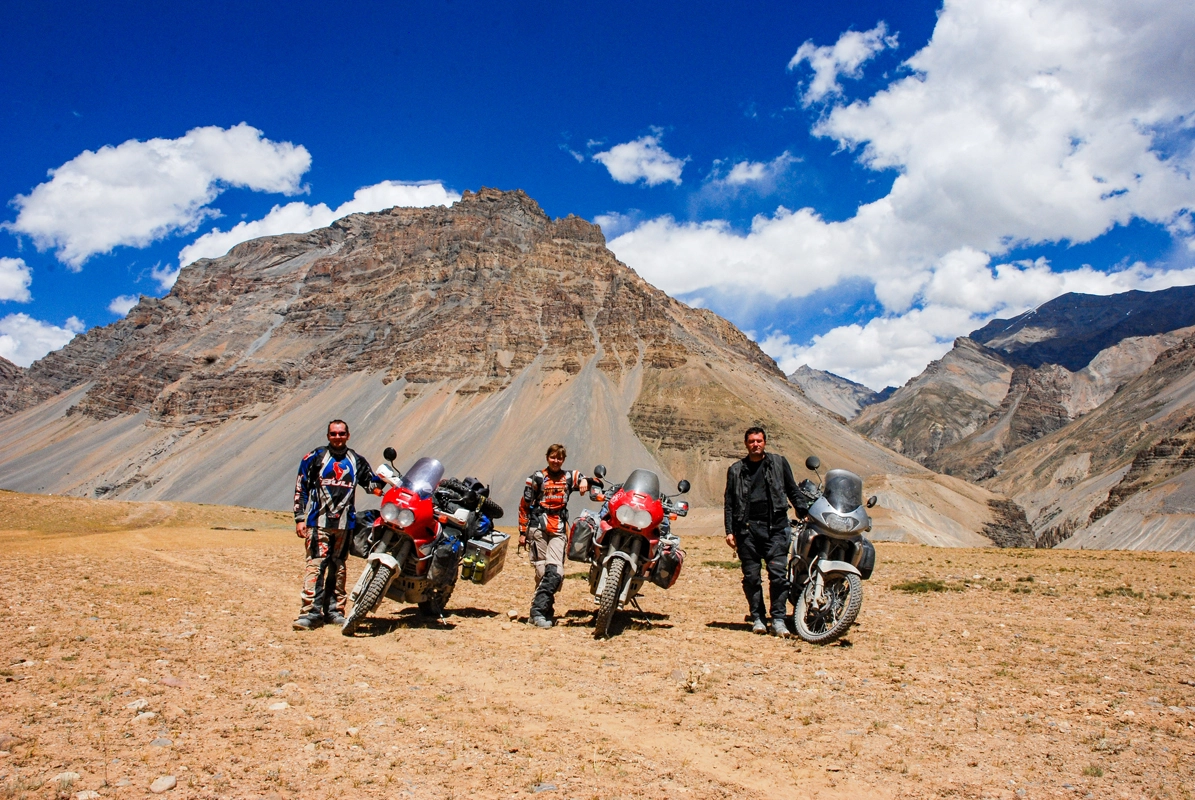
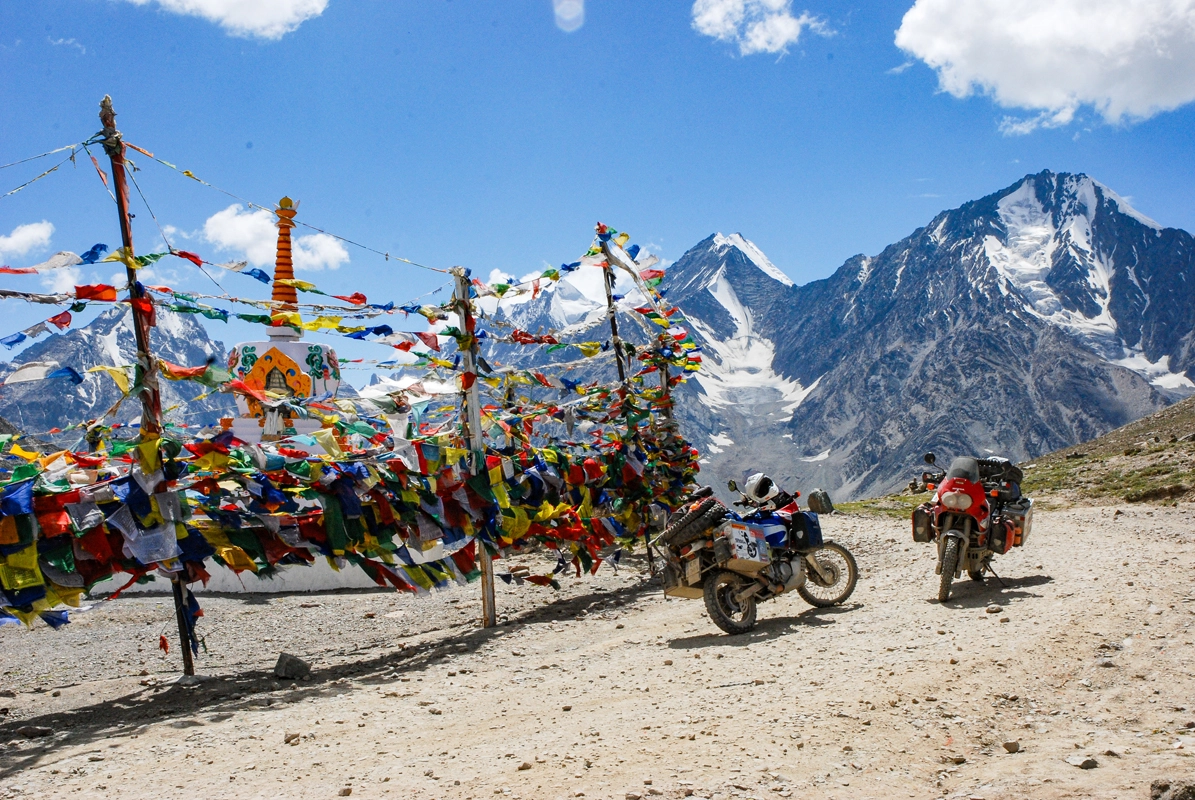
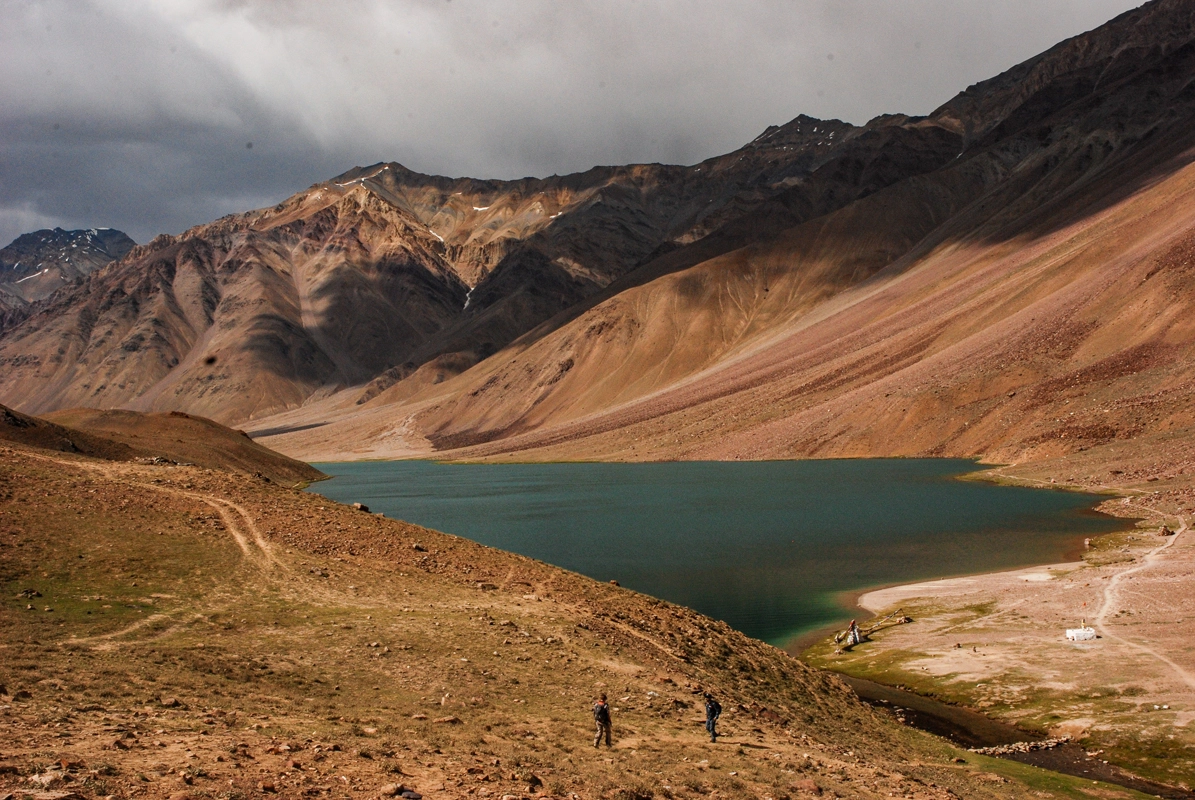
Crossing Baracha La and Lachalung La Passes
The next day could easily be dubbed the “Day of the Passes.” We had four major mountain passes to conquer, with the most spectacular and challenging being Baracha La (4980 m) and Lachalung La (5065 m). We set off early with a group riding Royal Enfield Himalayans, but they quickly fell behind. The climb to Baracha La was relatively straightforward, and we made good time, but as we approached the top, the weather took a turn for the worse. Dark clouds rolled in, bringing a noticeable drop in temperature compared to the warmer days we had been enjoying.
After descending from Baracha La, we stopped for lunch in Sarchu, a small cluster of roadside dhabas (local eateries). To our surprise and delight, we met two Polish travelers—our first encounter with fellow countrymen in India! It felt great to chat in our native language after so long. The next pass, Lachalung La, proved to be more difficult. The ascent began with a series of 25 sharp switchbacks cut into the mountainside. The road leveled out somewhat, but there was no sign of asphalt, just rough, rocky terrain.
Descending from Lachalung La was breathtaking. The landscape, with its unique rock formations, reminded us of the “Himalayan Cappadocia.” We couldn’t resist stopping frequently to take photos. After checking in at another police checkpoint, we headed toward Pang, a small settlement made up of a few dhaba tents, where we planned to spend the night.
We settled into one of the cozy dhabas, chatting with a group of French trekkers. Meanwhile, we awaited the arrival of Alberto and the group of Enfield riders. They had started later than us, but Alberto arrived soon after, followed by some of the Enfield riders. The last of the group rolled in around 9 p.m., navigating the dark, mountainous roads.
That night, we slept in the dhaba, crowded together with about 10 other people. At first, it was chilly due to the high altitude, but the warmth of so many bodies quickly raised the temperature inside. Unfortunately, the rare occurrence of rain hit during the night, and the dhaba wasn’t well-prepared for it. By the time the tent started leaking, the owner covered us all with a massive plastic sheet. We slept under our sleeping bags and the plastic cover, making it through the night relatively dry.
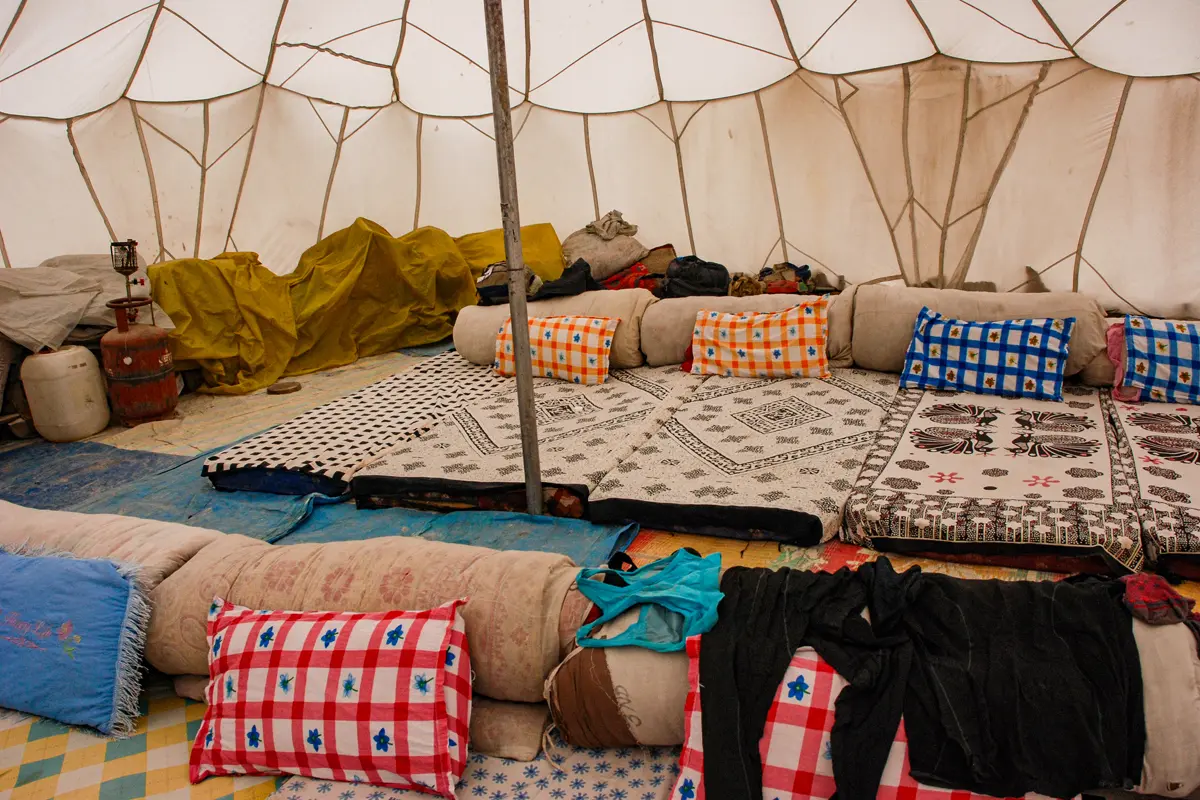
TO BE CONTINUED…
Join us on this incredible journey. Once or twice a month, you can expect another installment of our adventure. This way, you will feel the magic of those days, discover the beauty of the places we visited, and relive all the extraordinary moments with us. Each entry is not only a story of adventures but also of the challenges we encountered along the way, the people we met, and the cultures we had the chance to explore.
The world changes, but the memories of our travels remain eternal. What we experienced shaped us and enriched our lives with incredible experiences that we want to share with you. Each episode of our journey will give you the opportunity to travel through time and space, to places full of adventures, surprises, and beautiful landscapes.
We invite you to actively participate in this journey. We look forward to your comments and reflections, and maybe even your own travel stories! Your story can be an inspiration for us and other readers. Share your experiences, insights, and questions with us. Together, we will create a community of motorcycle travel enthusiasts, ready to share knowledge and memories. 🙂
FIND OUT MORE
Discover all the stages of our historic motorcycle journey from Poland to India. Read more about the Motorcycle Expedition to India with Aleksandra Trzaskowska.


Newsletter subscribers get more!
Join MotoBirds Soaring Newsletter and don't miss any important content, gear tests, travel inspirations and newest offers in the future! We'll also let you know about fresh publications on our blog.

